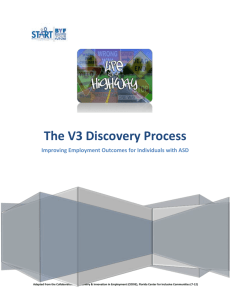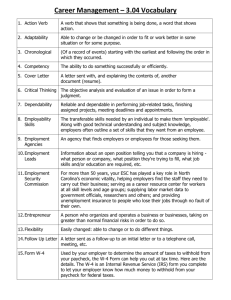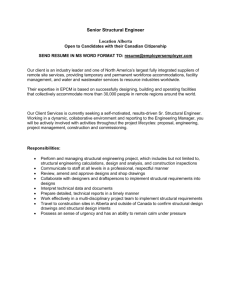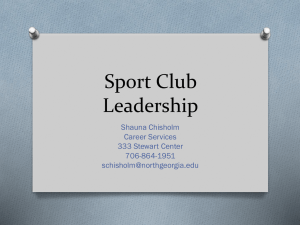V3 Discovery Summary - Vision, Vocational Profile, Visual Resume
advertisement
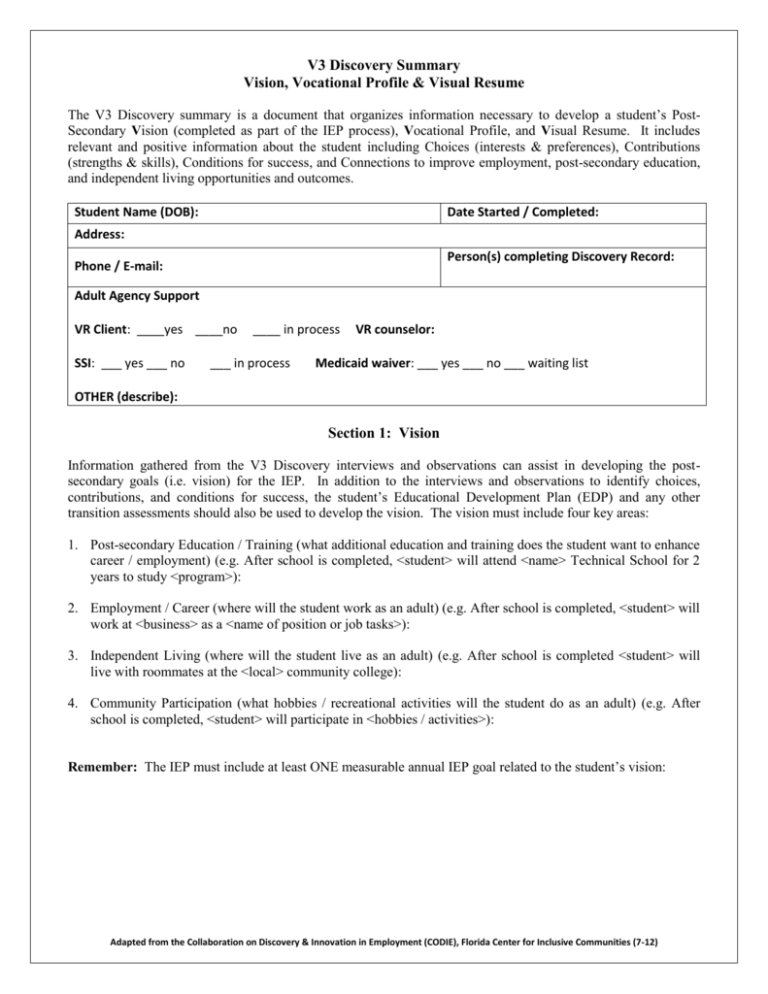
V3 Discovery Summary Vision, Vocational Profile & Visual Resume The V3 Discovery summary is a document that organizes information necessary to develop a student’s PostSecondary Vision (completed as part of the IEP process), Vocational Profile, and Visual Resume. It includes relevant and positive information about the student including Choices (interests & preferences), Contributions (strengths & skills), Conditions for success, and Connections to improve employment, post-secondary education, and independent living opportunities and outcomes. Student Name (DOB): Date Started / Completed: Address: Person(s) completing Discovery Record: Phone / E-mail: Adult Agency Support VR Client: ____yes ____no SSI: ___ yes ___ no ____ in process ___ in process VR counselor: Medicaid waiver: ___ yes ___ no ___ waiting list OTHER (describe): Section 1: Vision Information gathered from the V3 Discovery interviews and observations can assist in developing the postsecondary goals (i.e. vision) for the IEP. In addition to the interviews and observations to identify choices, contributions, and conditions for success, the student’s Educational Development Plan (EDP) and any other transition assessments should also be used to develop the vision. The vision must include four key areas: 1. Post-secondary Education / Training (what additional education and training does the student want to enhance career / employment) (e.g. After school is completed, <student> will attend <name> Technical School for 2 years to study <program>): 2. Employment / Career (where will the student work as an adult) (e.g. After school is completed, <student> will work at <business> as a <name of position or job tasks>): 3. Independent Living (where will the student live as an adult) (e.g. After school is completed <student> will live with roommates at the <local> community college): 4. Community Participation (what hobbies / recreational activities will the student do as an adult) (e.g. After school is completed, <student> will participate in <hobbies / activities>): Remember: The IEP must include at least ONE measurable annual IEP goal related to the student’s vision: Adapted from the Collaboration on Discovery & Innovation in Employment (CODIE), Florida Center for Inclusive Communities (7-12) Section 2: Vocational Profile & Brain Blizzard PART A: Vocational Profile: Use all the information gathered through record review, interviews and surveys, and ICIE observations to summarize the information into the following primary categories: 1. Choices (Interests & Preferences): Include personal passions, preferred and highly motivating interests and activities, and general areas of work, school or living preferences. 2. Contributions (skills): Include activities and tasks the student performs and skills demonstrated that may be seen as contributions to an employer (ex. punctual, orderly, memorization skills) or beneficial in independent living. Consider academic and non-academic skills (including task initiation, task engagement, and task completion), independence skills including managing a personal schedule, transitions from one activity to another, assembling / keeping track of own supplies (e.g. wallet, lunch, planner, communication system, etc.), communication skills, social interactions, use of technology, and self-determination / advocacy skills. 3. Conditions & Supports for Success: Ideal work or living conditions to ensure success include those environmental features that are in place when the student is at his/her best and is able to demonstrate skills, be independent, perform at full participation, and make the greatest contribution to the activity. Describe any noted conditions that are needed for the student to be successful and those that should be avoided. Translate any challenges the student may have into conditions for success and indicate situations to avoid. When writing about conditions, include what is needed regarding the physical environment, times of day, movement needs, social preferences, positive behavioral interventions and supports, personal supports, and instructional strategies. Adapted from the Collaboration on Discovery & Innovation in Employment (CODIE), Florida Center for Inclusive Communities (7-12) Part B: Brain Blizzard: The Brain Blizzard is a process of using the Vocational Profile information to accomplish the following: Develop a list of potential job opportunities related to vocational themes Identify job responsibilities, duties or tasks linked to identified theme areas Identify specific employers who may have these types of jobs / job tasks in their business Develop actions to facilitate job development The brain blizzard process adheres to the values associated with person-centered planning. The student with support from family or others as necessary holds the trump card in deciding what goes into the final plan for employment. Step 1: Use information gathered during the V3 Discovery process to identify three or four vocational themes that represent the blending of the student's choices (preferences), contributions (strengths & skills) and conditions necessary to ensure success. For example: "Books" or “Computers” may emerge as a theme areas from this information. Write 1 theme on each of 4 pieces of chart paper and post around the room. Step 2: Develop a list of potential skills, duties, or tasks that are within the identified theme areas consistent with the identified choices, contributions and conditions for success and record them on the chart paper and document below. For example: “Computers” is a potential theme area and "transcription from written notes or data entry into established databases" are possible responsibilities and work tasks. Note: Avoid listing specific job titles. Tasks Tasks Tasks Tasks Theme: 1. Theme: 1. Theme: 1. Theme: 1. 2. 2. 2. 2. 3. 3. 3. 3. 4. 4. 4. 4. Step 3: Have each team member list at least three employers / businesses in the local community consistent with the identified themes, tasks, and conditions for success. This will create about 20 employers / businesses per theme. Give each team member sticky notes and have them write one employer idea per post-it and place on the appropriate theme chart paper. Document results below: Employers Theme: 1. Employers Theme: 1. Employers Theme: 1. Employers Theme: 1. 2. 2. 2. 2. 3. 3. 3. 3. 4. 4. 4. 4. 5. 5. 5. 5. 6. 6. 6. 6. 7. 7. 7. 7. 8. 8. 8. 8. Adapted from the Collaboration on Discovery & Innovation in Employment (CODIE), Florida Center for Inclusive Communities (7-12) 9. 9. 9. 9. 10. 10. 10. 10. 11. 11. 11. 11. 12. 12. 12. 12. 13. 13. 13. 13. 14. 14. 14. 14. 15. 15. 15. 15. 16. 16. 16. 16. 17. 17. 17. 17. 18. 18. 18. 18. 19. 19. 19. 19. 20. 20. 20. 20. Step 4: Identify potential employers or employees that the student or family know that could be contacted about hiring the job seeker (Connections / Social Capital): Step 5: List potential NEW skills the student could learn if they were given employment or internship opportunities in these areas. These can be considered goal areas in the IEP: Adapted from the Collaboration on Discovery & Innovation in Employment (CODIE), Florida Center for Inclusive Communities (7-12) Section 3: The Visual Resume The visual resume takes the place of typical resumes and job applications in competitive employment situations. The visual resume is a combination of written information and photos in a visual format such as Microsoft PowerPoint, video or portfolio that depicts the student's skills, contributions, and tasks the student can perform. The visual resume is an effective tool because many individuals with developmental disabilities don’t compete well for jobs when more traditional comparative strategies are utilized such as completing an application for a job opening or providing a typical resume. The visual resume enables the job seeker to show off their talents, skills, experiences and tasks without being compared to other applicants or an existing job description. The visual resume is focused on drawing an employer’s focus to one individual and enables the employer to see this particular individual within their business. During V3 Discovery, information is learned about a student's strengths and abilities, areas of interest and knowledge, and activities they participate in within their community and or school. All this information is relevant in understanding the extent of the contribution the student can provide to potential employers. Format A good length of the Visual Resume is 8-10 pages. If it is too long you may lose the attention of the employer. To present the Visual Resume, use a computer, iPad, or hard copy in a stand up presentation binder. Photos Needed Portrait Photo Photos from that show the person being competent at work experiences, responsibilities at home, service learning Photos that display connections to the community (4-H, FFA, Church, Sports teams) Extracurricular activities, volunteer work, community service, etc. Photos that show off particular skills, interests, tasks or knowledge Tips: Turn off the date and time stamp on your camera. Take extra time to ensure that the person looks their best for the photo. Encourage the student to wear different clothes for different photos. Written Information Much of the written information content will be taken from the Section 2: Vocational Profile of the V3 Discovery Summary. Wording that is used in the visual resume is critical. Remember this is a marketing tool and your audience is business people. Use business language that is free of any human service jargon. i.e. Use “Performs yard work at home” vs. “helps with yard chores” and “Works well with coworkers” vs. “is friendly." Avoid “is able to….” Statements, be specific, and use action verbs instead. Make sure to always portray competence and emphasize strengths and abilities. Be respectful, but informative. Turn challenges into conditions for success and show supports that work. Include information from all the V3 Discovery Summary sections with a focus on past work experiences, tasks performed, and skills demonstrated. Ultimately the student's visual resume should be individualized for a specific employer presentation, so if some of the tasks are not relevant to that particular business they should be left out for that particular presentation. If a student has not had any formal work experience, explore ways to illustrate their skills and abilities by including a photograph of them performing chores at home or participating in an activity at home or in the community that illustrates some skills that are relevant to an employer. A compiled list of tasks should be the last page with a strong statement such as “Mary can perform these tasks for your business." The visual resume is a living creation; Add photos and update them as the student learns, grows, and experiences new things. Adapted from the Collaboration on Discovery & Innovation in Employment (CODIE), Florida Center for Inclusive Communities (7-12)
